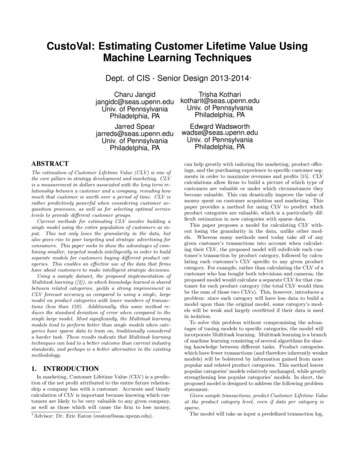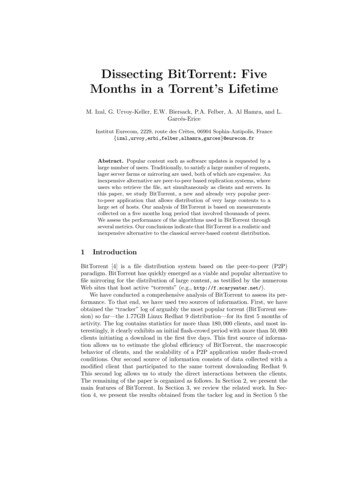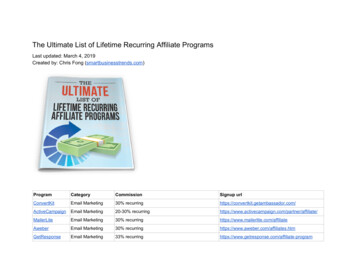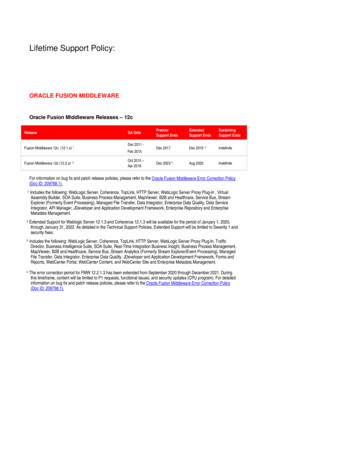
Transcription
CustoVal: Estimating Customer Lifetime Value UsingMachine Learning TechniquesDept. of CIS - Senior Design 2013-2014 Trisha KothariCharu Jangidjangidc@seas.upenn.edu kotharit@seas.upenn.eduUniv. of PennsylvaniaUniv. of PennsylvaniaPhiladelphia, PAPhiladelphia, PAEdward WadsworthJarred Spearjarreds@seas.upenn.edu wadse@seas.upenn.eduUniv. of PennsylvaniaUniv. of PennsylvaniaPhiladelphia, PAPhiladelphia, PAABSTRACTThe estimation of Customer Lifetime Value (CLV) is one ofthe core pillars in strategy development and marketing. CLVis a measurement in dollars associated with the long term relationship between a customer and a company, revealing howmuch that customer is worth over a period of time. CLV israther predictively powerful when considering customer acquisition processes, as well as for selecting optimal servicelevels to provide different customer groups.Current methods for estimating CLV involve building asingle model using the entire population of customers as input. This not only loses the granularity in the data, butalso gives rise to poor targeting and strategic advertising forconsumers. This paper seeks to show the advantages of combining smaller, targeted models intelligently in order to buildseparate models for customers buying different product categories. This enables an effective use of the data that firmshave about customers to make intelligent strategic decisions.Using a sample dataset, the proposed implementation ofMultitask learning ([2]), in which knowledge learned is sharedbetween related categories, yields a strong improvement inCLV forecast accuracy as compared to using a single, largemodel on product categories with lower numbers of transactions (less than 150). Additionally, this same method reduces the standard deviation of error when compared to thesingle large model. Most significantly, the Multitask learningmodels tend to perform better than single models when categories have sparse data to train on, traditionally considereda harder task. These results indicate that Multitask learningtechniques can lead to a better outcome than current industrystandards, and perhaps is a better alternative to the existingmethodology.1.INTRODUCTIONIn marketing, Customer Lifetime Value (CLV) is a prediction of the net profit attributed to the entire future relationship a company has with a customer. Accurate and timelycalculation of CLV is important because knowing which customers are likely to be very valuable to any given company,as well as those which will cause the firm to lose money, Advisor: Dr. Eric Eaton (eeaton@seas.upenn.edu).can help greatly with tailoring the marketing, product offerings, and the purchasing experience to specific customer segments in order to maximize revenues and profits [15]. CLVcalculations allow firms to build a picture of which type ofcustomers are valuable or under which circumstances theybecome valuable. This can drastically improve the value ofmoney spent on customer acquisition and marketing. Thispaper provides a method for using CLV to predict whichproduct categories are valuable, which is a particularly difficult estimation in new categories with sparse data.This paper proposes a model for calculating CLV without losing the granularity in the data, unlike other models. Whereas many methods used today take all of anygiven customer’s transactions into account when calculating their CLV, the proposed model will subdivide each customer’s transaction by product category, followed by calculating each customer’s CLV specific to any given productcategory. For example, rather than calculating the CLV of acustomer who has bought both televisions and cameras, theproposed model would calculate a separate CLV for that customer for each product category (the total CLV would thenbe the sum of those two CLVs). This, however, introduces aproblem: since each category will have less data to build amodel upon than the original model, some category’s models will be weak and largely overfitted if their data is usedin isolation.To solve this problem without compromising the advantages of tuning models to specific categories, the model willincorporate Multitask learning. Multitask learning is a branchof machine learning consisting of several algorithms for sharing knowledge between different tasks. Product categorieswhich have fewer transactions (and therefore inherently weakermodels) will be bolstered by information gained from morepopular and related product categories. This method leavespopular categories’ models relatively unchanged, while greatlystrengthening less popular categories’ models. In short, theproposed model is designed to address the following problemstatement:Given sample transactions, predict Customer Lifetime Valueat the product category level, even if data per category issparse.The model will take as input a predefined transaction log,
and it will output a CLV for each customer in each productcategory they have made purchases in. Additionally, useful graphics and other visualizations are produced based onthe output to make the data more accessible and useful inderiving key insights.This document examines related efforts at solving thisproblem, then outlines the schema and software implementation of the proposed system, and finally discusses the resultsof the system on sample data and looks towards potentialimprovements. First, it reviews the current research in calculating CLV so as to show how this approach is novel anduseful. Second, it describes the proposed model and its corresponding step-by-step implementation of an algorithm topredict CLV using Multitask learning. Then, it expoundson the evaluation criteria to be used to determine the success of this project and how well the model compares tothese criteria. Finally, suggestions for future improvementsor expansions are put forward and explained.2.2.2RFM ModelOne of the first attempts to gauge customer value was asystem called the RFM model, standing for Recency, Frequency, and Monetary Value. These models were originallyintended to determine how successful a direct marketingcampaign (e.g. postcards) would be to each customer, individually. They incorporated only three variables: the timebetween now and the customer’s last purchase, the averagetime between a customer’s purchases, and how much moneythe customer spends on any given purchase (Wei et al. [19]).The most typical application of this model would break customers up by quintiles on each of the three factors beinglooked at, yielding 125 groups of customers. Based on someformula, the costs of marketing to each cell and the predictedvalue from each cell would be calculated, and a breakevenline would be formed. The company would then deploy itsmarketing campaign to only target those cells which it considers could be profitable.This technique can be fairly readily applied so as to determine CLV. The technique is simple, intuitive, and does notrequire a large amount of complicated data. Essentially, acompany wishing to determine CLV of its customers wouldassume a constant direct marketing campaign for the remainder of each customer’s lifetime, and then determine theprofitability of each customer (Cheng et al. [3]). However,this technique has a number of drawbacks. The conceptof a constant marketing campaign is impractical; the campaign itself would be incredibly expensive and the customerswould eventually grow immune to it. Looking only at transaction histories without accounting for demographic factorscould lead to major oversights. Unless the formula is manually tweaked to backtest better, there is no impetus for themodel to learn from past successes and failures.The proposed approach will improve on the basic RFMmodel in a variety of ways. Most prominently, the tech-Econometric ModelsSome models exist that seek to take more covariates intoaccount than probability models, which typically only userecency, frequency and monetary value of transactions inorder to estimate the different elements of CLV.An example of this is the use of proportional hazard models to estimate how long customers will remain with the firm.The general form of these equations isλ(t, X) λ0 (t) exp(βX)RELATED WORKSeveral models have been used over the years to quantifyCLV. They have ranged from simplistic to complex, and theyhave incorporated ideas from diverse fields such as mathematics, econometrics, and computer science. The Multitasklearning model makes use of some of these models, and aimsto improve on all of them when data is sparse in some areasbut rich in others.2.1nique incorporates learning, thereby increasing the strengthof the model over time. It also accounts for sequential data,rather than selecting a fixed time period and looking only atthat bucket of data. Finally, as has been shown elsewhere(Gupta et al. [8]), models which incorporate more than thesethree factors do a better job predicting CLV than RFM models. Although RFM was not developed explicitly to calculateCLV, it is an important benchmark to be compared against.where λ is the hazard function, which is the probabilitythat the customer will leave the firm at time t given thatthey have remained with the firm until time t, and X is aset of covariates which may depend on time. λ0 is the basehazard rate; typical examples include the exponential model(in which case it is memoryless) or the Weibull model (tocapture time dependence). See Cox [4] for the original paperon proportional hazard models, and Knott et al. [11] for anexample of use.Once this hazard rate has been established, the survivorfunction is calculated as ZtS(t) P (T t) exp λ(u)du 0Where T is the actual time that the customer leaves thefirm. For the exponential distribution, the hazard functionis constant; this makes estimating the survival function relatively simple. There is also the following:P (T t) 1 S(t)If the time that customers leave the firm is known, thelikelihood of customers leaving can be estimated. Hence, topredict the function parameters (β), the total likelihood canbe maximized (or minimize log likelihood).While this use of covariates take more into considerationthan probability models, it focuses on aspects of CLV independently (for example, treating customer retention and theamount that customers spend separately). The proposed approach treats CLV as a final goal, allowing the shared basis,a representation of basis vectors to define each of the tasks,to act across these components.Furthermore, these models treat all customers equally.The proposed approach will be able to extract more fromthe given data by dividing the customers into sections, whilestill allowing each segment to learn from the others via theshared basis.2.3Persistence ModelPersistence models focus on modeling the behavior of components such as acquisition, retention and cross selling. These
models can be used to study how a change in one variable(such as a customer acquisition campaign) impacts othersystem variables over time. This approach can be used tostudy the impact of advertising, discounting and productquality on customer equity. It projects the long run or equilibrium behavior of a variable or group of variables of interest.For example, a firm’s acquisition campaign may be successful and bring in new customers (consumer response).That success may prompt the firm to invest in additionalcampaigns (performance feedback) and possibly finance thesecampaigns by diverting funds from other parts of its marketing mix (decision rules). At the same time, the firm’s competitors, fearful of a decline in market share, may counterwith their own acquisition campaigns (competitive reaction).Depending on the relative strength of these influence mechanisms, a long-run outcome will emerge that may or may notbe favorable to the initiating firm. Dynamic systems can bedeveloped to study the long run impact of a variable and itsrelationship with other variables.Persistence models are well suited for CLV because it isa long term performance metric. Such models help quantify the relative importance of the various influence mechanisms in long-term customer value development, includingcustomer selection, method of acquisition, word of mouthgeneration, and competitive reaction. However, this approach cannot perform well when there is little data to workwith, as it relies on consumer behaviors that only revealthemselves over longer periods of time.2.4Diffusion ModelUnlike the other approaches, the prime focus of the diffusion model is on Customer Equity (CE). The purpose ofthe more aggregated approach is that CLV often restricts itself to focus on customer selection, customer segmentation,campaign management, and customer targeting. A broaderapproach of integrating the CLV of both current and future customers can help produce a strategic metric usefulfor higher-level executives.In essence, CE is the sum of the CLV of future and current customers. There are two key approaches used in themeasurement of CE. The first is the production of probability models of acquiring a certain consumer using disaggregate data (Thomas 2001 [17]; Thomas, Blattberg, and Fox2004 [18]). This is primarily the methodology used by theapproaches described so far. The alternate approach is touse aggregate data and diffusion/growth models to predictnumber of customers likely to be acquired in the future.Gupta, Lehmann, and Stuart [9] showed that CE is a goodestimate for 60% of the five companies investigated. Theexceptions included eBay and Amazon, an indication of theweaknesses for the model to be applied with larger online retail firms. A particularly interesting insight of this approachis the relative importance of marketing and financial instruments, where a 1% change in retention would negativelyaffect the CE by 5%. This is in stark contrast with a similarchange in discount rate producing only a 0.9% change in CE.For example, a 45 million expenditure by Puffs facial tissues to increase its ads awareness ratings by
company wishing to determine CLV of its customers would assume a constant direct marketing campaign for the re-mainder of each customer’s lifetime, and then determine the pro tability of each customer (Cheng et al. [3]). However, this technique has a number of drawbacks. The concept of a constant marketing campaign is impractical; the cam-











